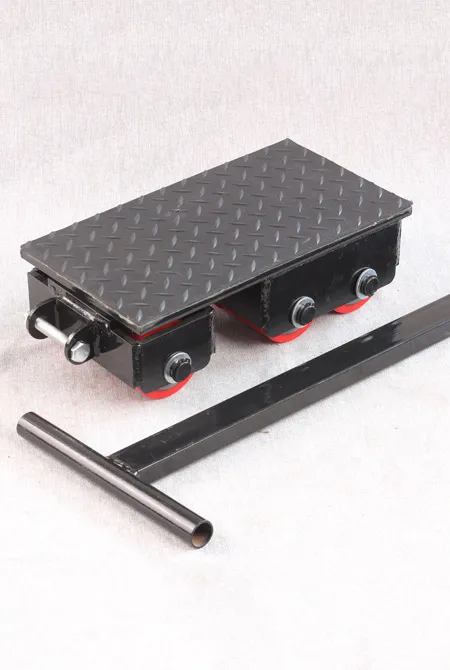Roller Solutions for Efficient Machine Relocation and Shifting Operations
Understanding Rollers for Machine Shifting A Comprehensive Guide
In the world of industrial operations, the effective movement of heavy machinery is crucial for maintaining productivity. One key component that facilitates this process is the roller. Rollers are essential tools utilized for machine shifting, enabling the efficient relocation of heavy equipment within facilities. This article delves into the significance of rollers for machine shifting, their types, benefits, and best practices for optimal usage.
What are Machine Rollers?
Machine rollers, often referred to as dollies or skate rollers, are devices designed to assist in the transportation of heavy loads. They typically consist of a series of wheels, either fixed or rotating, that reduce the friction between the load and the surface it is being moved on. Rollers can be used in various industries, including manufacturing, construction, and warehousing, to shift equipment such as machinery, generators, and heavy tools.
Types of Rollers
Rollers come in various types, each suited for specific applications. Some common types include
1. Conveyor Rollers Used in conveyor systems to facilitate continuous material movement. They can bear significant weight and are essential in assembly lines.
2. Furniture Rollers Often found in office spaces, these rollers help move heavy furniture without damaging floors. They are designed for lighter loads but are efficient in a different context.
3. Heavy-Duty Machinery Rollers Engineered to support extreme weights, these rollers are utilized for significant equipment shifting. They often have high-tensile strength materials and can withstand considerable impact.
4. Pallet Rollers Used for moving palletized goods, these rollers simplify the logistics of loading and unloading trucks and storage areas.
5. Skate Rollers Ideal for moving machinery across flat surfaces, skate rollers offer a range of motion and can easily fit under various machine frames.
Benefits of Using Rollers
The use of rollers in machine shifting offers several advantages
1. Reduced Labor Costs Rollers significantly decrease the effort required to move heavy machinery, resulting in lower labor costs and increased efficiency.
roller for machine shifting

2. Enhanced Safety Moving heavy equipment can be perilous, but rollers minimize the risk of injury to workers by allowing safe transport, reducing the need for manual lifting.
3. Increased Flexibility Rollers allow for greater maneuverability within a workspace. Machinery can be repositioned easily, making assembly, maintenance, or reconfiguration processes more straightforward.
4. Surface Protection By reducing direct contact with flooring, rollers help to protect surfaces from scratches and damage, especially valuable in environments with concrete or hardwood floors.
5. Improved Efficiency The speed at which equipment can be moved is heightened with the use of rollers, leading to increased operational efficiency and reduced downtime.
Best Practices for Using Rollers
To maximize the effectiveness of rollers in machine shifting, consider the following best practices
1. Choose the Right Roller Selecting the appropriate type and load capacity for the specific machinery is essential. Using inadequate rollers can lead to accidents or equipment damage.
2. Regular Maintenance Ensure that rollers are regularly inspected and maintained. Check for wear and tear, lubricate moving parts, and replace them as necessary.
3. Train Personnel All personnel involved in the moving process should receive proper training on how to use rollers safely and effectively to prevent accidents.
4. Plan Movements Before shifting heavy machinery, plan the route to avoid obstacles and ensure that the area is clear, reducing the risk of accidents or damage.
5. Use Proper Techniques When loading or unloading machinery onto rollers, utilize correct techniques to maintain balance and stability, ensuring that the load is evenly distributed.
Conclusion
Rollers play a vital role in the efficient and safe shifting of heavy machinery in various industrial settings. With an array of types and applications, they not only speed up moving processes but also enhance safety and reduce costs. By adhering to best practices and ensuring the right selection of rollers, businesses can significantly improve their operational efficiency while safeguarding their equipment and workforce. Embracing the advantages of machine shifting rollers is a smart investment for any industrial operation.
-
Portable 2000 lb Gantry Crane | Heavy-Duty & AdjustableNewsAug.30,2025
-
Versatile Lifting Solutions with Gantry and Overhead CranesNewsAug.29,2025
-
The Versatile Mobile Gantry Crane SolutionNewsAug.29,2025
-
Reliable Movement with Heavy Machinery Skates and RollersNewsAug.29,2025
-
Reliable Lifting Performance with 2000 lb Gantry Crane and 2 Ton Overhead SystemsNewsAug.29,2025
-
Maximize Lifting Efficiency with PML Magnetic LiftersNewsAug.29,2025
-
Efficient Relocation Starts with Reliable Machinery MoversNewsAug.29,2025
